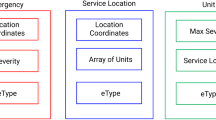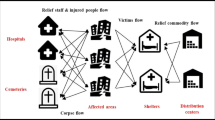Abstract
Allocating emergency resources effectively is an essential aspect of disaster preparation and response. The Emergency Siting Problem (ESP) involves identifying the best places to locate emergency services in order that it can serve the most people in the least amount of time. Maintaining time limitations is of greatest significance in situations where each second matters, such as during disasters or public health emergencies. In this study, we concentrate on the difficulty of solving the ESP under extreme time limits. In this research, Genetic-adaptive reptile search optimization (GRSO) is proposed to provide a different way to solve the ESP problem within the constraints of limited time. The proposed GRSO method takes into account travel times, prospective facility places, and the geographic location of demand sites while keeping to the established time restrictions. In this study, the proposed method demonstrating superior performance accuracy in locating transportation facilities under extreme time limits for Emergency Service Planning (ESP), outperforming established optimization strategies and heuristics commonly applied to ESP problems. A fitness function is created to assess the standard of responses based on elements including response speed, coverage, and meeting deadlines. The GRSO algorithm has been modified and altered to handle the distinctive features of the ESP, such as precise facility placements and time constraints. Simulated and real-world datasets describing emergency circumstances are used in computational research to confirm the efficiency of the proposed method. The results are evaluated with established optimization strategies and heuristics generally applied to ESP problems. Results show that the GRSOapproach provides solutions that are more in pace with time limit constraints without sacrificing sufficient degrees of coverage or response time.











Similar content being viewed by others
References
Li, P., Fan, X.: The Application of the Improved Jellyfish Search Algorithm in a Site Selection Model of an Emergency Logistics Distribution Center Considering Time Satisfaction. Biomimetics 8(4), 349 (2023)
Xu, W., Xu, J., Proverbs, D., Zhang, Y.: A hybrid decision-making approach for locating rescue materials storage points under public emergencies. Kybernetes 53(1), 293–313 (2022)
Liu, J., Li, Y., Li, Y., Zibo, C., Lian, X., Zhang, Y.: Location optimization of emergency medical facilities for public health emergencies in megacities based on genetic algorithm. Eng. Constr. Archit. Manag. 30(8), 3330–3356 (2022)
Newton, R.A., Kumara, S., Ventura, J.A. and Griffin, P.M.: A Generalized Model for Including Equity in the Siting of Emergency Services (2022)
Karatas, M., Yakıcı, E.: An iterative solution approach to a multi-objective facility location problem. Appl. Soft Comput.Comput. 62, 272–287 (2018)
Han, S., Park, J., Jeong, H.: A solution procedure for emergency logistics problem in disaster scene. Industrial Engineering & Management Systems 17(2), 166–176 (2018)
Yan, X., Hou, H., Yang, J., Fang, J.: Site Selection and Layout of Material Reserve Based on Emergency Demand Graduation under Large-Scale Earthquake. Sustainability 13(3), 1236 (2021)
Alizadeh, R., Nishi, T.: A genetic algorithm for multi-period location problem with modular emergency facilities and backup services. Transactions of the Institute of Systems, Control and Information Engineers 32(10), 370–377 (2019)
Yu, W., Guan, M., Chen, Y.: Fire stations siting with multiple objectives and geospatial big data. Earth Sci. Inf. 14, 141–160 (2021)
Yang, B., Wu, L., Xiong, J., Zhang, Y. and Chen, L.: Planning of location and path for urban emergency rescue by an approach with hybridization of clustering and ant colony algorithm. Available at SSRN 4041695 (2022)
Trivedi, A., Singh, A.: A hybrid multi-objective decision model for emergency shelter location-relocation projects using fuzzy analytic hierarchy process and goal programming approach. Int. J. Project Manage. 35(5), 827–840 (2017)
Rodríguez-Espíndola, O., Albores, P., Brewster, C.: Disaster preparedness in humanitarian logistics: A collaborative approach for resource management in floods. Eur. J. Oper. Res.Oper. Res. 264(3), 978–993 (2018)
Manopiniwes, W., Irohara, T.: Stochastic optimisation model for integrated decisions on relief supply chains: preparedness for disaster response. Int. J. Prod. Res. 55(4), 979–996 (2017)
He, J., Feng, C., Hu, D., Liang, L.: A decision model for emergency warehouse location based on a novel stochastic MCDA method: evidence from China. Math. Probl. Eng. 2017, 1–10 (2017)
Alosta, A., Elmansuri, O., Badi, I.: Resolving a location selection problem by means of an integrated AHP-RAFSI approach. Reports in Mechanical Engineering 2(1), 135–142 (2021)
Zhang, B., Peng, J., Li, S.: Covering location problem of emergency service facilities in an uncertain environment. Appl. Math. Model. 51, 429–447 (2017)
Demir, E.: Approach for siting a support facility for transporting supplies in emergency cases in the Republic of Bulgaria. MATEC Web Conf. 234, 06001 (2018)
Alizadeh, R., Nishi, T.: Hybrid set covering and dynamic modular covering location problem: application to an emergency humanitarian logistics problem. Appl. Sci. 10(20), 7110 (2020)
Rizeei, H.M., Pradhan, B., Saharkhiz, M.A.: Allocation of emergency response centres in response to pluvial flooding-prone demand points using integrated multiple layer perceptron and maximum coverage location problem models. International Journal of Disaster Risk Reduction 38, 101205 (2019)
Zhou, J., and Shao, Y.: Rational selection of rail transit emergency site using complex network topology and genetic algorithm. Scientific Programming, 2022 (2022)
Cui, S., Liu, S., Tang, X. and Zhu, T.: March. Emergency material allocation problem considering post-disaster impact. In 2019 8th International Conference on Industrial Technology and Management (ICITM) (pp. 290–294). IEEE (2019)
Geng, J., Hou, H., Geng, S.: Optimization of warehouse location and supplies allocation for emergency rescue under joint government–enterprise cooperation considering disaster victims’ distress perception. Sustainability 13(19), 10560 (2021)
Babaei, A., Shahanaghi, K.: A new model for planning the distributed facilities locations under emergency conditions and uncertainty space in relief logistics. Uncertain Supply Chain Management 5(2), 105–125 (2017)
Zhao, M., Chen, Q.W., Ma, J. and Cai, D.: Optimizing Temporary Rescue Facility Locations for Large-Scale Urban Environmental Emergencies to Improve Public Safety. Journal of Environmental Informatics, 29(1) (2017)
Gai, L., Peng, Z., Zhang, J., Zhang, J.: Emergency medical center location problem with people evacuation solved by extended TODIM and objective programming. J. Comb. Optim.Optim. 42, 1004–1029 (2021)
Funding
R&D Program of Beijing Municipal Education Commission, KM202310020001.
Author information
Authors and Affiliations
Contributions
All authors contributed to the study conception and design.All authors read and approved the final manuscript
Corresponding authors
Ethics declarations
Competing interests
The authors declare no competing interests.
Additional information
Publisher's Note
Springer Nature remains neutral with regard to jurisdictional claims in published maps and institutional affiliations.
Rights and permissions
Springer Nature or its licensor (e.g. a society or other partner) holds exclusive rights to this article under a publishing agreement with the author(s) or other rightsholder(s); author self-archiving of the accepted manuscript version of this article is solely governed by the terms of such publishing agreement and applicable law.
About this article
Cite this article
Zhao, W., Gao, W., Gao, S. et al. Quantum competitive decision algorithm for the emergency siting problem under given deadline conditions. Cluster Comput 27, 13029–13046 (2024). https://doi.org/10.1007/s10586-024-04548-7
Received:
Revised:
Accepted:
Published:
Issue Date:
DOI: https://doi.org/10.1007/s10586-024-04548-7




